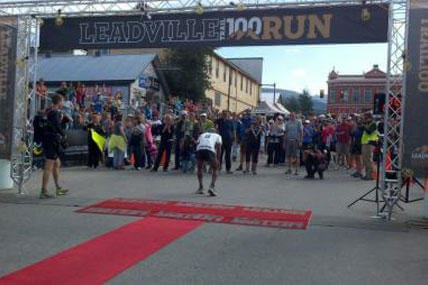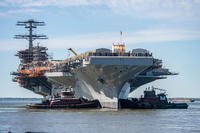JOINT BASE LEWIS-MCCHORD, Wash. – To successfully complete the Grand Slam of Ultra-running, a runner has to successfully complete four of America’s toughest 100-mile races, which consists of the Western States 100 in California, the Vermont 100 Mile Endurance Run in Vermont, the Wasatch Front 100-Mile Endurance Run in Utah, and the Leadville Trail 100 in Colorado.
According to Stan Jenson, manager of the runs100 website, which tracks ultra running statistics, Only 288 people in the world have ever gone on to successfully complete the Grand Slam.
In September, Maj. Jonathan Shark, the 2-2 Stryker Brigade Combat Team, 7th Infantry Division human resources officer in charge, became one of them.
“All races were extremely tough mountain runs with elevation gain ranging from 14,500 feet to 27,000 feet of climbing, at altitudes ranging from 3,000 feet to 12,600 feet above sea level. [In the end], the statistics are staggering,” said Col. Louis Zeisman, 2-2 SBCT commander, in an email. “In total, Shark ran 400 miles in 120 hours and climbed over 76,000 feet: Mt. Everest is 29,000 feet tall. [This is] an outstanding achievement from one of my key players.”
Shark didn’t start running until after a deployment to Afghanistan in 2010, and finished his first 100-mile race in August 2011.
“So between November 2010 and August 2011 all I did was run. I ended up running like 10 marathons, three 50-mile races, and seven 50 kilometers. I don’t even know how many miles I spent running training runs,” said Shark. “I finished my first 100 in August 2011. The cut-off was 30 hours and I finished it in 29 hours and 39 minutes, so it was a success. When I crossed the finish line I was like, ‘I’m never gonna run another 100 miles again.’ That lasted like a month.”
Shark described his recovery from his first 100-miler as a month of not being able to walk.
“About a month later the holes started to close up. The blisters started to heal over. I was able to start walking again. I said, ‘You know what, I’m gonna do another 100,’ but I ended up coming [to JBLM] and deploying in 2012,” Shark said.
The 2-2 SBCT deployed to Afghanistan in April 2012 and returned in January 2013.
“2012 was spent pretty much all in Afghanistan, so I didn’t get a chance to do any races for a while. I had never even heard of the Grand Slam because I was a relatively new runner,” said Shark. “Well this time while I was in Afghanistan I read about the Grand Slam and it seemed like it was this mythical, totally unachievable [goal]. I remember 100 [miles], how much that was, and that was the Leadville 100. The Leadville 100 is only one of the four 100s that you have to do for the Grand Slam.”
Shark reminisced on the Leadville 100, remembering how painful it was.
“I heard about the Grand Slam and I thought, ‘How could anyone do all four of these?’ I only did one and [it felt like] I almost died,” said Shark. “How could anyone do all four? So I said, ‘You know what, I gotta do the Grand Slam because that’s the only way I’ll find out how anybody could do it.'”
This year, 36 runners set out to conquer the Grand Slam, but only 22 finished, with Shark finishing in 20th place.
Shark still recalls the day he decided to start ultra-running and it all started with one magazine article.
“When I was in Afghanistan two tours ago I saw this magazine that was called Runner’s World. At the time I had never run before so I had never seen a Runner’s World magazine,” said Shark. “There was this article about this dude named David Goggins. David Goggins, who, they would have it, is one of the best runners in the world. This guy was a ultra marathon runner, [and] I was intrigued. The dude is a Navy SEAL. He’s an active duty Navy SEAL, who had a mission gone wrong and lost like half his team members. His way of coping with the loss was trying to raise money for the family members of his fallen teammates. So he goes online and finds the 10 hardest things to do in the world, and the Badwater pops up.”
The Badwater Marathon is often described by runners as the world’s toughest footrace. It consists of 135 miles through Death Valley in California and runners can only compete by invitation only.
“[Goggins] doesn’t know it, but Badwater is like this super elite race. You have to be invited to run. First you have to qualify,” said Shark. “Goggins contacts the race director and says, ‘Hey, I want to run your race to raise money for fallen soldiers and their families.”
Shark goes on to explain that the race director required him to run a minimum of one 100-mile race before allowing him to compete in the Badwater Marathon. Typically runners can’t participate in the Badwater Marathon if they haven’t completed a minimum of three 100-mile races.
“He finds this 100-mile race that happens to be like a week later and he runs, finishing in some ridiculous time,” said Shark.
Goggins finished his first 100-mile race in 2005 in 19 hours at the 24-Hour Race in San Diego, Calif.
“I thought to myself, ‘If that dude could run a hundred miles with absolutely no training, then I could run a hundred miles if I trained. Maybe not fast, but I could at least finish,” said Shark.
Shark attributes much of his determination to succeed at ultra running to his time in the military.
“The military has taught me a lot as far the mental toughness that you need to run these things. It takes a lot of discipline. It takes a lot repetition. It takes a lot of dedication. Those are all values that the Army has really helped me develop,” said Shark.
Shark also attributes his success to completing the Grand Slam of Ultra-Running to Col. Louis Zeisman and Command Sgt. Maj. Timothy Dotson, the command team of 2-2 SBCT, 7th ID, by thanking them for their support.
“I spent all summer traveling, and I when I wasn’t traveling I was training. Col. Zeisman and Command Sgt. Maj. Dotson have been completely and utterly supportive of my efforts, and that’s huge,” said Shark.



























